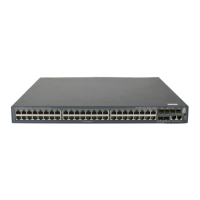145
Ste
Command
Remarks
2. Add a Web proxy server
port number.
portal web-proxy port port-number
By default, no Web proxy
server port number is
configured and proxied HTTP
requests cannot trigger portal
authentication.
Enabling support for portal user moving
Only Layer 2 portal authentication supports this feature.
In scenarios where there are hubs, Layer 2 switches, or APs between users and the access devices, if an
authenticated user moves from the current access port to another Layer 2-portal-authentication-enabled
port of the device without logging off, the user cannot get online when the original port is still up. The
reason is that the original port is still maintaining the authentication information of the user and the
device does not permit such a user to get online from another port by default.
To solve the problem described above, enable support for portal user moving on the device. Then, when
a user moves from a port of the device to another, the device provides services in either of the following
ways:
• If the original port is still up and the two ports belong to the same VLAN, the device allows the user
to continue to access the network without re-authentication, and uses the new port information for
user accounting.
• If the original port is down or the two ports belong to different VLANs, the device removes the
authentication information of the user from the original port and authenticates the user on the new
port.
To enable support for portal user moving:
Ste
Command
Remarks
1. Enter system view.
system-view N/A
2. Enable support for portal
user moving.
portal move-mode auto Disabled by default
For a user with authorization information (such as authorized VLAN) configured, after the user moves
from a port to another, the switch tries to assign the authorization information to the new port. If the
operation fails, the switch deletes the user's information from the original port and re-authenticates the
user on the new port.
Specifying an Auth-Fail VLAN for portal
authentication
Only Layer 2 portal authentication supports this feature.
This task sets the Auth-Fail VLAN to be assigned to users failing portal authentication. You can specify
different Auth-Fail VLANs for portal authentication on different ports. A port can be specified with only
one Auth-Fail VLAN for portal authentication.

